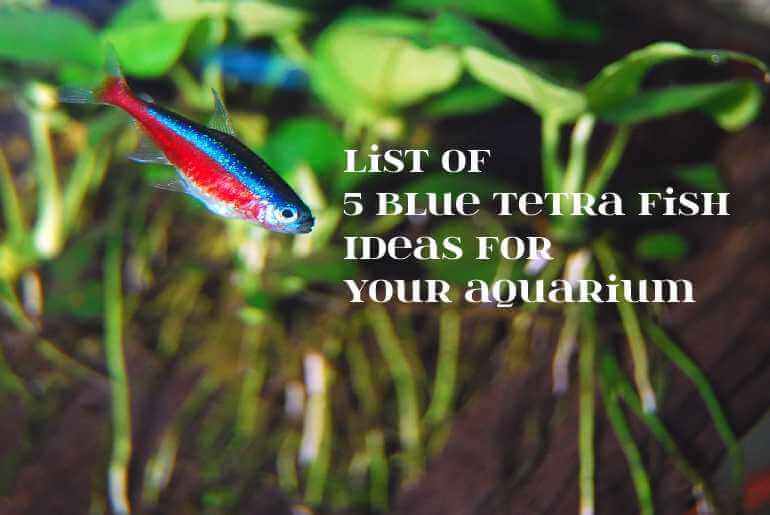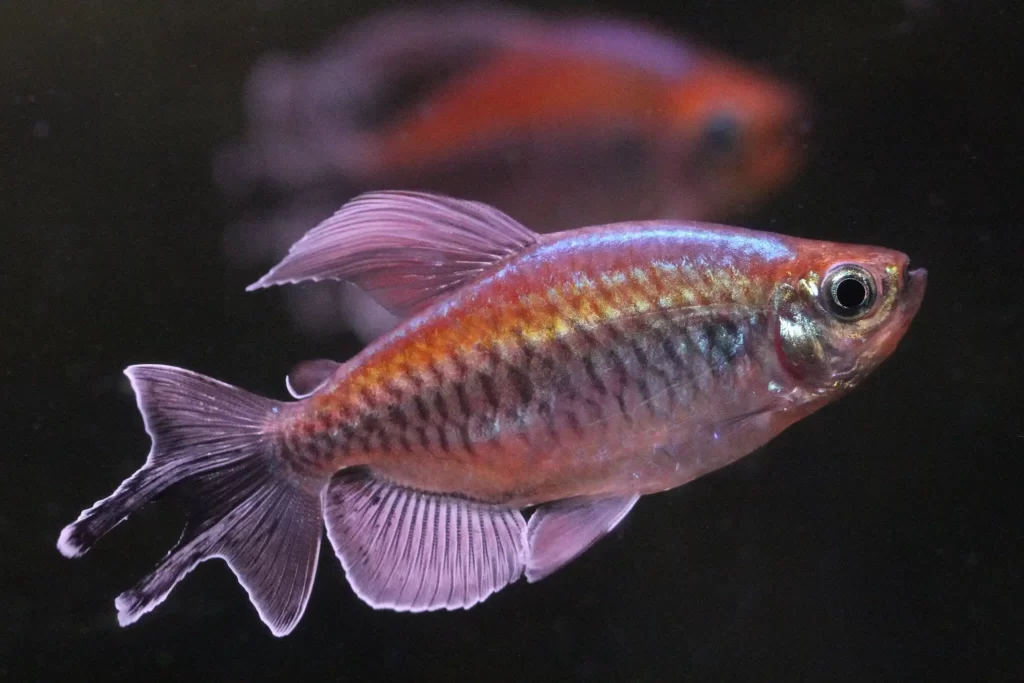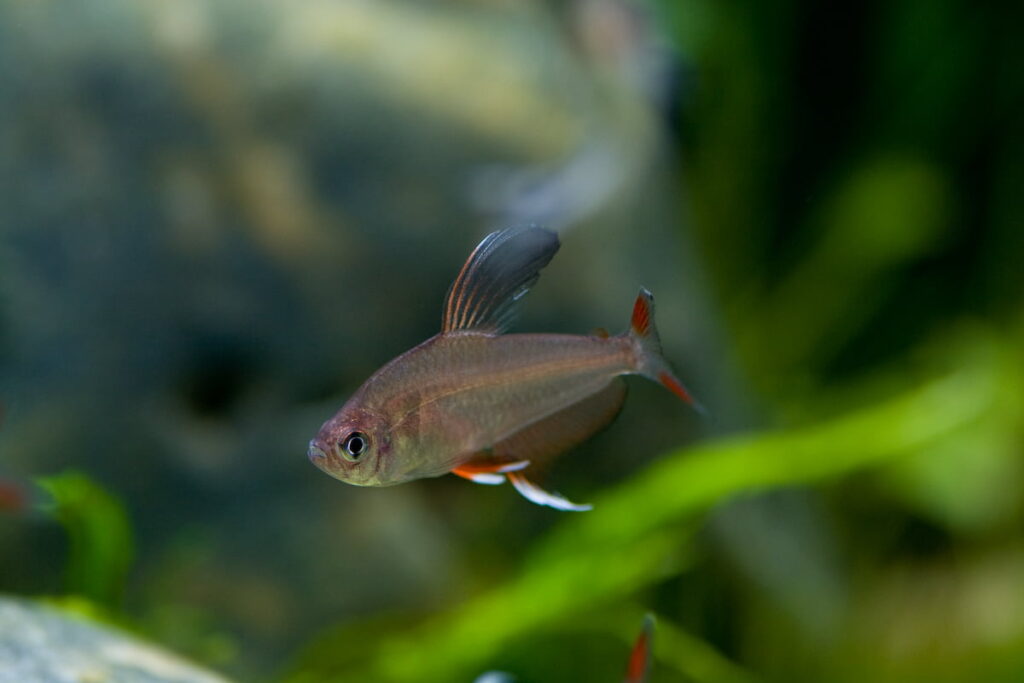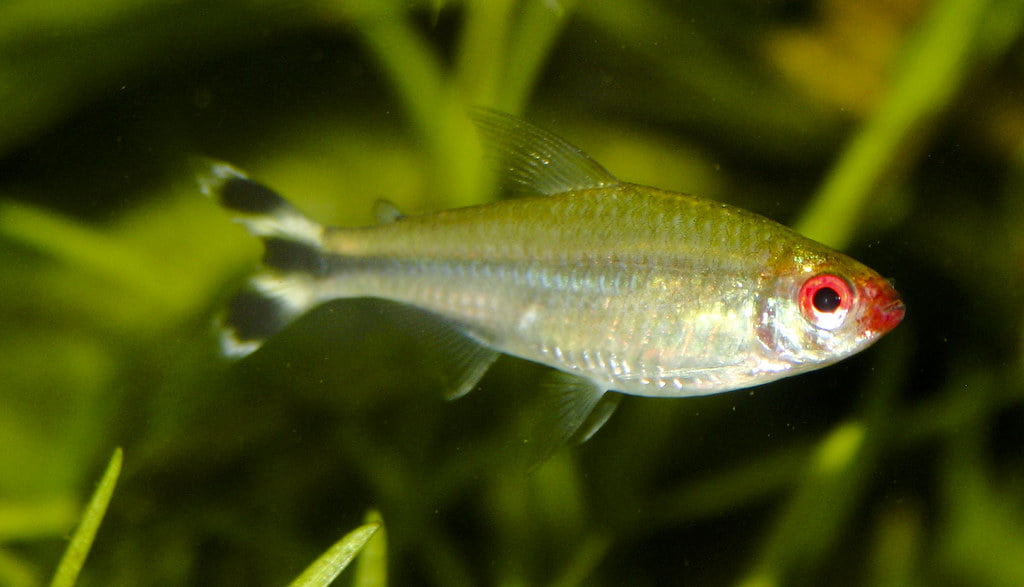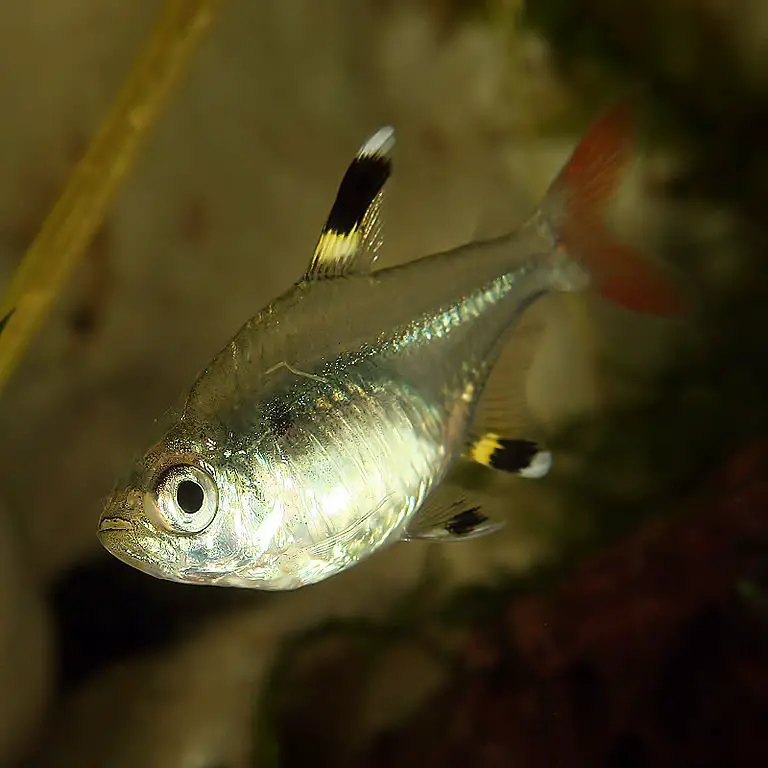Generally, I have seen many fishkeepers being confused while getting a fish in their aquarium. It happens because selecting particular fish kinds from various species is very tricky. Here, I suggest you pick Tetra fish, best in blue, as they have always been absolute for the aquarium. So, to help you out, here is a list of 5 blue color Tetra fish ideas for your aquarium.
So, ‘What are some of the 5- best blue color Tetra fish for the aquarium?’ Some of the 5 Blue Tetra fish like Cochu’s Blue Tetra (Boehlkea Fredcochui), Blue Tetra (Knodus Borki), Neon Tetras, Cardinal Tetra, and Red-Blue Colombian Tetra are best for the aquarium. These Tetra fish usually attracts many aquarists with their charming blue appearances. Besides, they are also easy to handle as they are gentle and well-behaved.
Hence, you can consider these Blue Tetras for your aquarium with complete certainty. Even if you are a beginner fishkeeper, you can go for these beautiful Blue Tetras as they are easygoing and not very demanding.
List Of 5 Blue Color Tetra Fish Ideas For Your Aquarium
At present, Tetras has been the best choice of many fishkeepers for their aquarium. Tetras not only looks elegant but behaves finely too.
Within various Tetras, Blue colored Tetra fish has been making many fishkeepers inclined towards them. They are most attractive amongst many other red, yellow, blue, and black colored Tetra fish. So, here is a list of 5 blue Tetra fish, among which you can pick your favorite Blue Tetra for your aquarium:
Cochu’s Blue Tetra (Boehlkea Fredcochui)
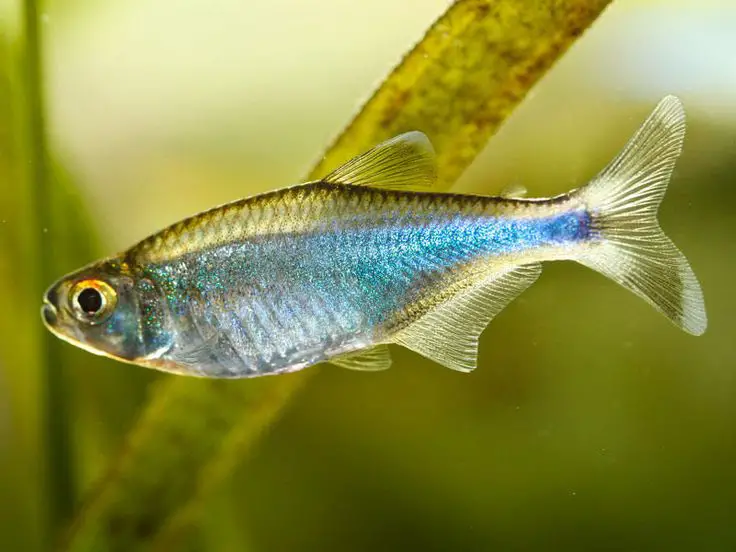
- Size: Up to 2 inches (approximately 5 centimeters)
- Care Level: Easy to moderate
- Expected Life Span: 2 to 3 years
- Water Temperature: 72 to 82 degrees of Fahrenheit (22 to 28 degrees of Celsius)
- Water Hardness: 5 to 12 dH(degree Hardness)
- pH scale: 6 – 7.5
- Tank Requirement: At least 20-gallon tank at minimum
A Tetra fish of a total blue appearance is something you are looking for, aren’t you? Then, here it is, as its name says, Cochu’s Blue Tetra.
Cochu’s Blue Tetras are original to streams of Amazon River basins of Southern America.
Body Structure And Color
Like the name says, the body color of Cochu’s Tetra is finely blue. It doesn’t have any vast color variations but blue in major. You can see the color conversion from light blue to deep dark blue, and sometimes pink in Cochu’s Tetra. It entirely depends on their health conditions.
The body of Cochu’s Tetra is sleek and largely transparent, including the fins. However, you can see some deeply immersed scales at its center portions.
Here, the bodies of male Cochu’s Tetras are slimmer with bolder shades than the female Cochu’s Tetras.
More About Cochu’s Blue Tetra
Cochu’s Blue Tetras are an elegant schooling fish that has to be in a group of at least six while placing in an aquarium. However, they are notable among many fishes due to their pretty blue appearance. This amazing Cochu’s Tetra will thrive in your aquarium if you look after them properly.
Moreover, they don’t require any complex requirements apart from general water conditions and tank setup. Providing them an adequate tank space by minimizing supplementary live plants and selecting fitting tank mates is significant for their activeness and flourishing.
However, the breeding period of Cochu’s Tetras can slightly create difficulty for some aquarists. It is because the Cochu’s Tetras usually scatters their eggs at the planted area in the tank. In such conditions, it becomes tough to manage the tank environment to encourage the hatching correctly.
Cochu’s Blue Tetras Tank Mates
Cochu’s Blue Tetras are schooling fish. They must be kept with their species primarily, but they can also get along with other species. Hence, you can put those species with Cochu’s Blue Tetras in a tank as their tank mates.
You can choose some of the best species like Ember Tetras, Small Cichlids, and other peaceful Tetra species as tank mates for Cochu’s Blue Tetras.
But make sure you don’t go for a large number of fish with Cochu’s Blue Tetras in a single tank. It can lead to overcrowding, which can make Cochu’s Blue Tetras inactive and aggressive.
Blue Tetra (Knodus Borki)
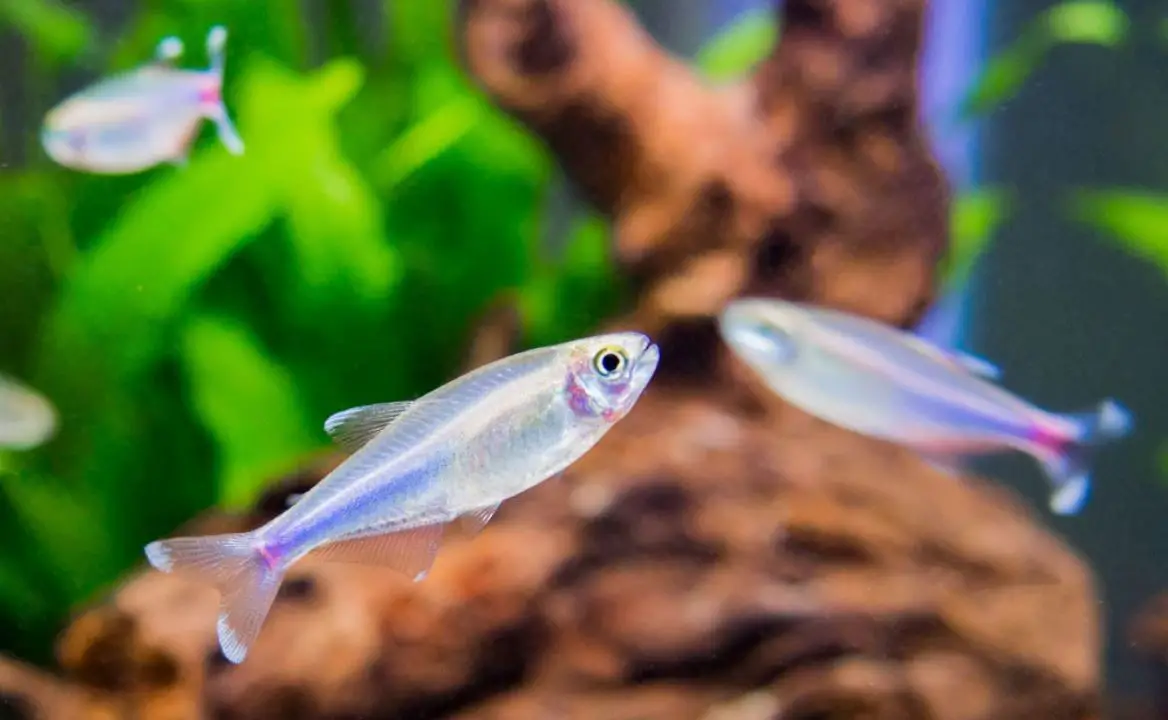
- Size: 2 inches (approximately 5 centimeters)
- Care Level: Easy
- Expected Life Span: 2 to 4 years
- Water Temperature: 72 to 78 degrees of Fahrenheit (22 to 25 degrees of Celsius)
- Water Hardness: 5 to 12 dH(degree Hardness)
- pH scale: 5.5 – 7
- Tank Requirement: At least 20-gallon tank at minimum
To avoid confusion, let me clarify that Blue Tetras are different from the Cochu’s Blue Tetras. So, for the precision, here I will call Blue Tetras from their scientific name, Knodus Borki.
Knoduses are blue-colored Tetra fish that are native to the rivers and streams of Brazil and Colombia. These Tetras often live in densely planted regions.
Body Structure And Color Of Blue Tetras
Knoduses have an extended and a bit compressed body structure. The primary color of their body is blue-green to bright blue. The back area, leaving the fins, is green with deep bordered scales.
Knoduses have shining and more vivid scattered blue scales in their body. A light blue line is noticeable in their transparent fins. On a dark background of a tank, the fins of Knoduses appear like a blemish of shade floating.
Knodus Borki In An Aquarium
Likewise, even in an aquarium, you should place adequate live plants with some knotted branches to give the presence of a natural environment to Knoduses. It will provide them a suitable environment and also creates dispersed tank lighting. The dispersed tank lighting keeps Knoduses active as they tend to be somewhat lazy. The more natural presence you provide to them, the extra they shine in your aquarium.
Furthermore, you have to keep in mind that the Knodus is a schooling fish. Thus, you have to place them in a group of at least eight of them while keeping them in a tank. As this Tetra has to settle in a group, you can avoid keeping other smaller species in a smaller tank with them. It leads to overcrowding and builds anxiety in them.
Also, there is a high chance that Knoduses can nip the fins of other smaller species due to stress in smaller or overcrowded tanks.
Can I Select Some Tank Mates For Blue Tetras (Knodus Bolki)?
Yes, you can select some tank mates for Blue Tetras (Knodus Bolki) apart from their school. For selection, go for small-sized species only as Knodus itself is a small-sized fish. Also, it would be best if you get tank mates of having similar nature to Knodus.
You can get Barbs, Danios, and other small Tetras as tank mates for Blue Tetras (Knodus Bolki).
Neon Tetra (Paracheirodon Innesi)
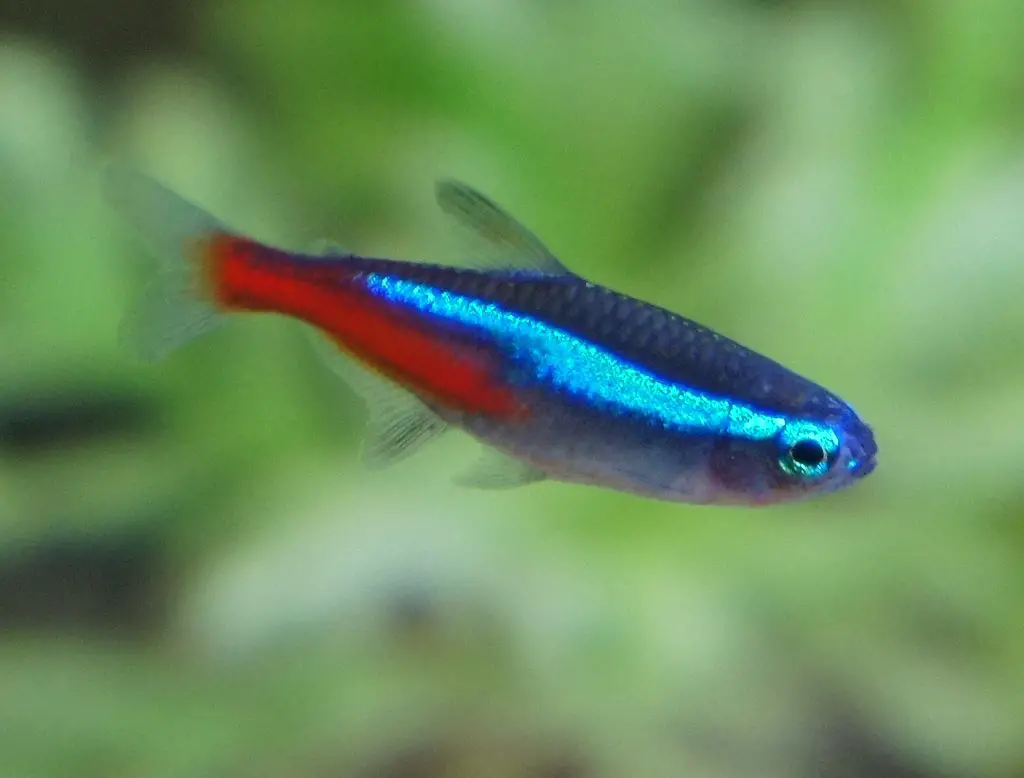
- Size: 1.2 inches (approximately 3 centimeters)
- Care Level: Easy
- Expected Life Span: 8 years
- Water Temperature: 72 to 78 degrees of Fahrenheit (22 to 25 degrees of Celsius)
- Water Hardness: 2 to 10 dH(degree Hardness)
- pH scale: 5.5 – 6.2
- Tank Requirement: 10-gallon tank in minimum
I know you might be thinking why Neon Tetra is in a list of Blue Tetra fish. I agree that Neon Tetras are not wholly blue, but it has a tint of blue in its body. So, somewhat it represents as one of the blue Tetras order. Hence, I couldn’t miss Neon Tetras to list over here!
Neon Tetras are from the rivers and streams of South America. They typically prefer to stay in dense plantations, even in an aquarium. Thus, an adequate placement of live plants is significant to provide a natural feel to the Neon Tetras in an aquarium.
Neon Tetras Appearance In Brief
Neon Tetra has been the most common freshwater schooling fish species at present. It has been ideal as its striking shades of red and bright blue comes to notice generally.
Here, the red color is visible only at the middle part and slightly in the lower half of the Neon Tetra’s body. On the other hand, the blue shade is apparent from their eyes to their tail fins. However, sometimes, Neon Tetras can dim their colors if they are panicking or in any fear.
Due to such exciting highlights of Neon Tetras, many aquarists prefer keeping them at their aquarium. Not only this, but they are easy to care for and maintain as well.
Neon Tetras In Aquarium
As Neon Tetras are schooling fish, you must keep them in a group of a minimum of 6 of them. Schooling them is a primary thing to remember while keeping them in a tank. By schooling, it keeps Neon Tetras peaceful, active, and friendly.
Apart from this, you should also thoroughly maintain the general water conditions and tank environment requisite for them.
Hence, Neon Tetras are quite ideal fish to keep in your aquarium as they require less maintenance and care level. Also, a beginner fish keeper can opt for this Tetra with certainty.
What Are Some Best Tank Mates For Neon Tetras?
Neon Tetras are peaceful schooling fish. They get along with most of the species if their mates aren’t dominating or aggressive.
Here are some of the best tank mates that you can choose for Neon Tetras:
- Cardinal Tetras
- Guppies
- Zebra Danio
- Mollies
- Corydoras Catfish
- Otocinclus Catfish etc.
Cardinal Tetra (Paracheirodon Axelrodi)
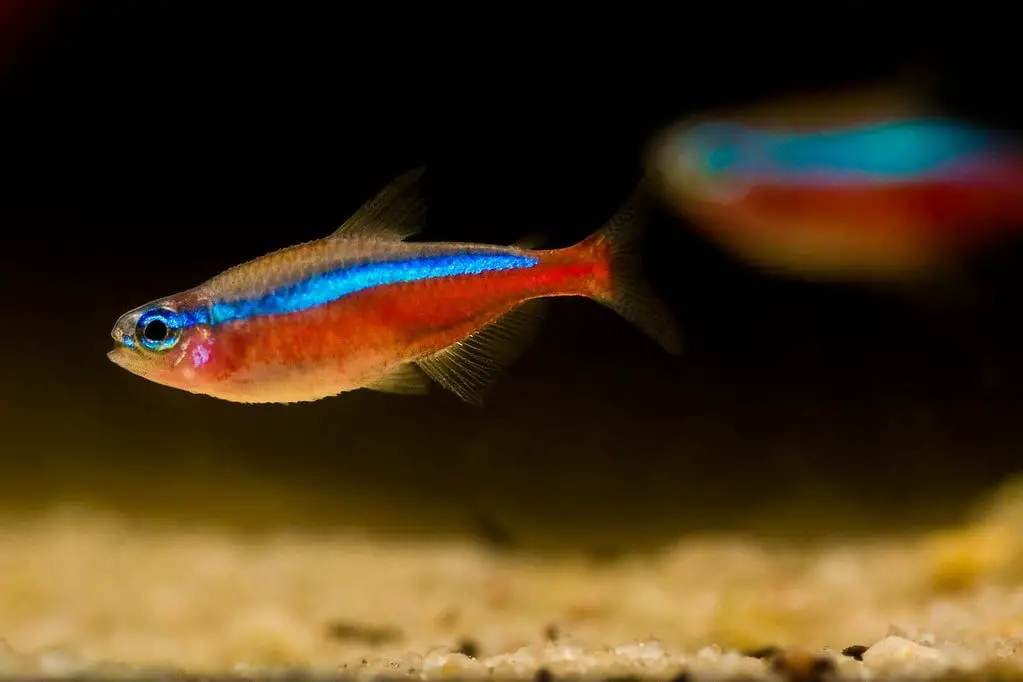
- Size: 2 inches (approximately 5 centimeters)
- Care Level: Easy to moderate
- Expected Life Span: Around 5years
- Water Temperature: 73 to 81 degrees of Fahrenheit (23 to 27 degrees of Celsius)
- Water Hardness: 2 to 4.5 dH(degree Hardness)
- pH scale: 5.5 – 7
- Tank Requirement: 20-gallon tank in minimum
Like Neon Tetras, Cardinal Tetras are also not a whole blue-colored Tetra fish. But as Cardinal Tetra carries some spark of blue shade, I have to list it as well.
If you have never seen a Cardinal Tetra before, then let me tell you it kind of looks like a Neon Tetra. Either it be their body color or size, both Tetras seem similar. Also, Cardinal Tetras are native to the streams of South America, like Neon Tetras.
Are Cardinal Tetras And Neon Tetras The Same Fish Species?
Many people confuse Cardinal Tetras with Neon Tetras or vice-versa. A single glance of both Tetras can put anyone in a dilemma, especially to a new fishkeeper.
In general, Cardinal Tetra also has a bright blue and red body shade, just like a Neon Tetra. Their body shades are identical. They both are small-sized and schooling fish too. Also, they both prefer dense live plants in a tank to get a natural presence around them.
Moreover, like Neon Tetras, Cardinal Tetras should also stay in a school of at least 4 to keep them peaceful and active. Otherwise, the Cardinals may get aggressive, although they are calm and friendly in actuality.
As there are such high similarities between these two Tetras, yet there is something that distinguishes them precisely. Neon Tetra has red color in its middle portion and slightly at a lower back portion in its body. However, in Cardinal Tetras, the layer of red shade spreads in every part of their body.
Therefore, no, Cardinal Tetras and Neon Tetras are not the same fish species. They look alike, but they aren’t complete identicals.
Tank Mates For Cardinal Tetra
Like Neon Tetra, Cardinal Tetra are also quite friendly and peaceful with other calm and gentle species. So, you can get some other tank mates for Cardinal Tetras apart from its school.
So, the tank mates that you can choose for Cardinal Tetras are:
- Neon Tetras
- Guppies
- Zebra Danios
- Angelfish
- Dwarf Gourami
- Mollies
- Hatchetfish, etc.
Red-Blue Colombian Tetra (Hyphessobrycon Columbianus)
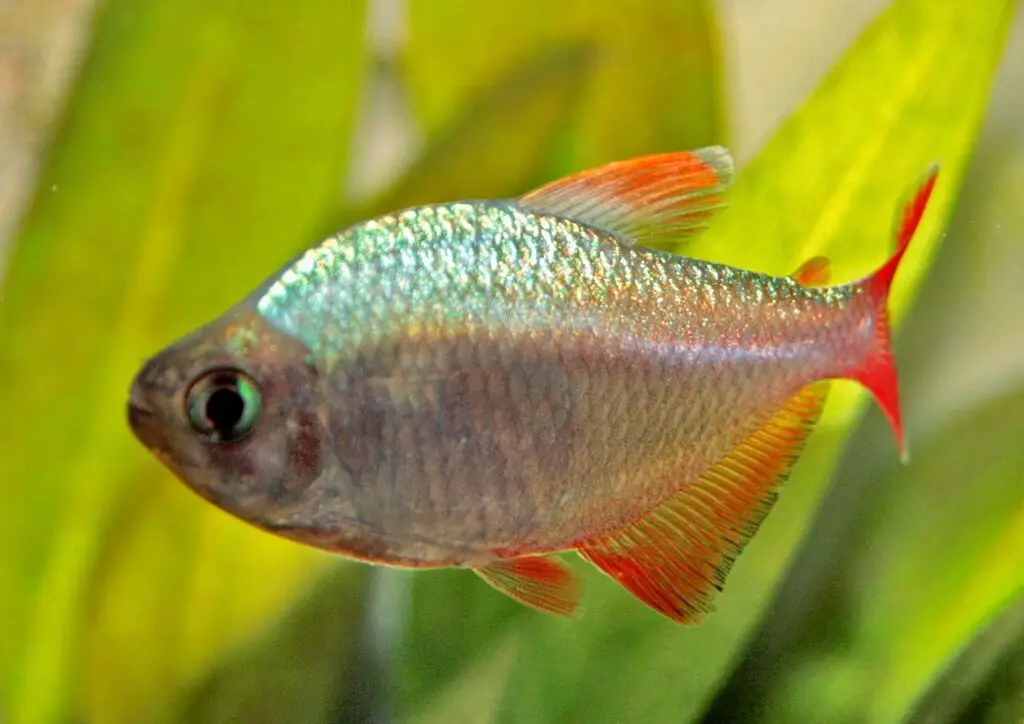
- Size: Up to 2 inches (approximately 5 centimeters)
- Care Level: Easy to medium
- Expected Lifespan: 3 to 5 years
- Water Temperature: 73 to 80 degrees of Fahrenheit (22 to 26 degrees of Celsius)
- Water Hardness: 6 to 14 dH(degree Hardness)
- pH scale: 6 – 7
- Tank Requirement: At least 30-gallon tank at minimum
Scientifically named Hyphessobrycon columbianus, Red-Blue Colombian Tetra is somewhat a Blue Tetra fish, like its title suggests. It is native to the Atlantic coast of Columbia. It has got some other names like: Colombian Tetra and Red Tail Mirror Blue Tetra.
The Colombian Tetras are schooling fish. Meaning, you should keep them in a group of at least 6, which will add charm to the aquarium.
Body Structure And Color
Its body structure is unlikely to what a Tetra fish generally has. The stout form towards the front body of Red-Blue Colombian Tetra makes it different and noticeable. This fish is not slender like a usual Tetra.
You can see the top part of Colombian Tetras in silvery grey. On top of this, the deep blue tone shades for a vivid stripe. Similarly, the fins of the fish are in bright red.
Thus, the overall body color of Colombian Tetra seems red and blue, which ended on being its widespread name as well.
Behavior Of Colombian Tetra
Just like the body structure, the behavior of Colombian Tetra is also slightly different from other Tetras. Thus, understanding their behavior is very crucial.
The Red-Blue Colombian Tetras are also peaceful and calm fish. But their calmness can turn into aggression in no minute. Such transform of behavior takes place if the fish feels bothersome from its tank mates and tank environment.
Similarly, if you place Colombian Tetra solely or not in a proper group, its aggressive nature is pretty evident.
Thus, maintaining a pleasant tank environment, choosing suitable tank mates, and placing Colombian Tetras in a group are essential factors to keep this Tetra fish calm and friendly. By doing this, you can help them to dodge through aggression.
What Are Some Best Tank Mates For Red-Blue Colombian Tetra?
Some of the best tank mates for Red-Blue Colombian Tetra are:
- Zebra Danios
- Tiger Barb
- Black Skirt Tetra
- Silver Hatchets
- Corydoras.
Why Should I Choose A Blue Tetra Fish For My Aquarium?
Nowadays, choosing Tetra fish for the aquarium has been a pretty common thing. Aquarists love not just the Tetras’ behavior but their fascinating colors as well. These widespread Tetras hold different shades like yellow, blue, red, black, and even a spectrum. Here, you may think, ‘if there are many colored Tetra fish, why should I prefer a Blue Tetra fish more?’
Commonly, the blue-colored Tetra fish is mainly noticeable amongst many other colored Tetra fish. It generally adds more shine in the aquarium by playing a role of a fluorescent. In a way, its shade acts as a lighting of an aquarium. And of course! Who doesn’t like their aquarium to brighten up?
Moreover, in most of the aquariums, the only blue shade that you can spot might be the color of water. Usually, the tank environment contains many elements where the possibility of blue components is somewhat low. So, by choosing a blue Tetra fish, you can brighten your aquarium a more extra.
What To Feed Tetras?
Every wondered what such tiny creatures eat to survive? Don’t worry! I will help you in knowing about it.
Feeding the 5 blue major Tetra fish of a list is quite convenient than you think. However, they tend to eat whatever small piece that fits in their mouth, which sometimes can be unsuitable for them. Thus, it is significant to make sure about their diet.
Firstly, note that the listed 5 Blue Tetras are all omnivorous. They usually prefer being carnivore often. So, you may see these Blue Tetras eating other micro invertebrates likely in a tank.
Moreover, these Tetras are not so picky in eating. They will accept different kinds of foods that you provide them. Here, the foods may include flakes, pellets, and some frozen or dry diets. You can feed some live foods like Daphnia, Bloodworms, and Brine Shrimp to them as it supplies plenty of nutrients.
However, not to forget about greens in their food as it is equally significant. Providing some high balance of plant elementary foods can provide more nutrients to them.
Besides, nowadays, you can get many fish diets in the market. Such foods contain all essential nutrients that are essential for Tetras. Also, note that a high-quality micro flake must be a central essence in their diet.
How Many Times A Day Should I Feed Tetras?
Feed your Tetras twice a day only. Here, the feeding span should no longer last than 2 minutes.
As all the listed Tetras are schooling fish, I would suggest you get an automatic food dispenser. The food dispenser will assist you in avoiding overfeeding the Tetras.
Points To Keep In Mind While Keeping Blue Color Tetra Fish In Aquarium
Till here, I have mentioned a list of some 5 striking blue Tetra fish for your aquarium. To help you a little more, I will list some points that you should remember while keeping these Tetras in your aquarium. These points will help you in taking better care of your Tetras.
The points are:
- All 5 blue color Tetra fish of a list are schooling fish. So, you must keep them in a particular group by considering the tank size. If you isolate or solely keep any of the Tetras, it would negatively affect your fish and brings out their aggressive nature.
- Monitor the water parameters and tank environment often. If you see any fluctuations in water parameters, promptly correct them. Also, have adequate lighting in the tank and keep the water of the tank sanitary.
- Choose the tank mates for Blue Tetra fish wisely. Otherwise, the fish may not get along with each other and end up fighting.
- Don’t overcrowd the tank. Place the Blue Tetra fish in a pleasant tank where the number of fishes and tank decorations are not excessive.
- The Blue Tetra fish often eats both plants and tiny creatures in a tank. That’s why you should place every element with caution in a tank. Otherwise, the Tetras may swallow without a thought.
- During the breeding period of Blue Tetra fish, monitor the tank more carefully. Sometimes, there might be a problem like water getting quickly dirty, inadequate diet, lack of hidden spot, aggression (due to fertility) in a tank. You should watch and rectify such happenings.
Conclusion
Among many other colored Tetras, blue Tetra fish usually glow in most of the tanks. So, I have made a list of the main 5 blue Tetra fish above for you.
Here, if you want a whole blue-colored Tetra fish, you can choose either Cochu’s Blue Tetra or Blue Tetras (Knodus Borki). But if you are looking for a Tetra that includes a bit of shade of blue, you would love Neon Tetra, Cardinal Tetra, and Red-blue Colombian Tetra.
The 5 blue Tetra fish of a list are the schooling fish that are easy to care for and manage. Thus, even a beginner aquarist can certainly get any of the Blue Tetra fish.
However, for breeding of Cardinal Tetra and Cochu’s Blue Tetra may require additional care that can cause trouble for beginner aquarists. So, I would recommend beginner aquarists to pick another Blue Tetra fish from the above list.
Lastly, pick any of the Blue Tetra fish wisely and take their proper care so that they thrive better in your aquarium.
